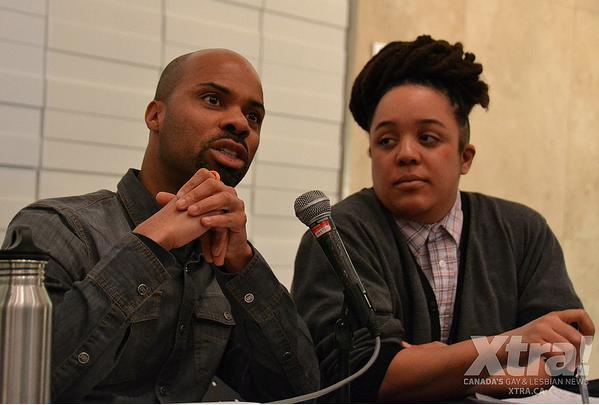Courtnay McFarlane calls out names at the Queering Black History discussion on Feb 28 in Toronto: “Faith Nolan, Dionne Brand, Sherona Hall, Angela Robertson.” Some are well known; others are pulled from obscurity.
Hundreds fill the expansive atrium in Ryerson University’s engineering building. McFarlane, manager of youth services at Davenport-Perth Community Health Centre, takes the audience back through three decades of queer black history in Toronto. He calls out more names. Audience members murmur in agreement.
“At the time we were straddling the public and the private — private lives in public spaces, public policy and private relationships,” he says. “It was not unusual to see black gay men refused entry at bars.”
The other panellists include Syrus Marcus Ware, program coordinator at the Art Gallery of Ontario; Notisha Massaquoi, executive director of Women’s Health in Women’s Hands Community Health Centre; and Rinaldo Walcott, an associate professor at OISE/University of Toronto in the department of sociology and equity studies in education. Robertson, chair of Black CAP and director of equity and community engagement at Women’s College Hospital, moderates the discussion.
Speaking about the beginnings of Blockorama in 1998, Walcott says, “One hopes those moments were documented, that writers are turning those stories into scripts… Keeping stories about black queer life in Canada, we failed at this. We have to piece our history together.”
“Our archives are boxed up in garages,” Ware adds.
Stored inside a box is where the other half of the story of South African gay rights activist Simon Nkoli was found, Massaquoi says. Nkoli was instrumental in ensuring rights are enshrined in the constitution. In the 1980s he spent four years in prison for anti-apartheid activism.
While behind bars, he wrote numerous letters to leaders, supporters and activists. “He had a lot of time on his hands,” she says. The responses to his letters were found in the South African Gay and Lesbian archives.
“There were letters from Toronto, Canada. They asked if I knew any names,” she says. So Massaquoi contacted the letter-writers. One was Toronto’s Tim McCaskell.
“[McCaskell] provided all the information and spent hours scanning each letter into the computer and getting them to the archives in South Africa,” she says.
Interestingly, McCaskell stumbled on Nkoli’s fight while sifting through international news while working for The Body Politic, he writes in a June 22, 2010, article for Canadian Dimension.
“The Body Politic’s reports on the case inspired a number of local queer activists, and in early 1986, about a dozen of us came together and formed The Simon Nkoli Anti-Apartheid Committee. The SNAAC provided Simon with emotional and material support. Prison was very hard. We corresponded regularly,” McCaskell writes.
A picture of a woman appears on the screen. “Bev Ditsie, a friend of Nkoli. She was the first to stand up at a Pride parade in Africa and declare herself a lesbian,” Massaquoi says.
Another picture. A smiling David Kato, the activist who was viciously beaten to death with a hammer at his home in Uganda on Jan 27. He was one of 100 gay activists targeted by a Ugandan newspaper campaign.
“Now they are trying to keep 20 witnesses alive to testify at the murder trial,” Massaquoi says.
In honour of Kato, a photo campaign, To David With Love, was launched Feb 14, asking people to take a picture of themselves holding a written message. In some pictures people covered their faces. “The goal is to create a history, to be part of history,” she says. The photo messages will be sent to Kato’s organization, Sexual Minorities Uganda (SMUG).
At the end, an audience member asks about the myth that African and Caribbean black people are more homophobic. “Is that myth perpetuated?”
“I think the notion that black people are more homophobic is bullshit,” Walcott says, pointing and leaning in close to the microphone. “They may express their bigotry in more vulgar ways.
“Every year people come to the gay village from small towns. What are they running from? Homophobia.”
Ware speaks about how little history exists about black trans activists. “Black trans history in Toronto and Canada is invisible. Why is so little information known in our community?”
Ware says black trans men and women were some of the first on the frontlines in the post-Stonewall riots. “It is absolutely true; black trans were the first on the street.”
“Very quickly trans people were left out of the organizing. These are the stories that are just not told,” he says. “The notion that black trans is a new thing is completely fiction.”
No names are called by Ware.
“I would love to call out names, but because of the particularly of our community, some are in transition, some are not out,” he says. “We have an oral history and we’re often isolated.”

 Why you can trust Xtra
Why you can trust Xtra


